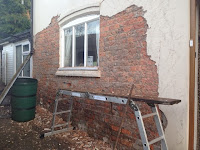 |
| Courtesy of http://stonecottagerenovation.blogspot.co.uk/ |
The majority of old solid stone and brick houses are covered in a liberal amount of cement render these days. I will assume that you know my opinion on cement render on solid walls, so I won't have my normal rant. Ranting about it does not solve the problem - just makes me feel a bit better. I had to live with cement render for many years before I had the opportunity to get it removed and a proper lime render re-instated. Many people who live in old houses do not have the resources needed to undertake this fairly major task. So what to do?
The theory behind using cement render was that by having a water proof finish on the wall it would keep the wall dry. Of course the issues of ground water, cracks, building movement and faults compromises this and so it does get wet and hence then retains the water in the structure. But if you cannot afford the time and expense of replacement you need to address the issue of maintenance.
Maintenance is the often overlooked factor of owning a house. We tend to think in terms of rent vs mortgage rather than the reality of rent vs mortgage AND maintenance (let alone improvement!). Maintenance is key to the success of any home. If you repair all cracks when they appear, ensure that gutters are clear at least once a year etc then you can avoid many of the potential pit falls of having an inappropriate finish on your home. Of course these are all temporary fixes, as it is like putting a plaster on a perpetual wound, but it is better than just leaving the wound to get infected.
So if you have got cement render on your walls try and make a habit of the following checks:
1. Guttering - ensure that there are no leaks and that all the water is draining away freely
2. Cracked render - ensure that all cracks are gauged out and repaired
3. 'Blown render' - tap the render to see if there are any areas where it 'rings hollow'. These areas should be removed and replaced with new render
4. Silicon seals around doors and windows - silicon fails over time and it is a common area where water gets behind the render. So check for failure and replace where needed
5. Compare the outside ground level with the internal floor level. Make sure that any work does not create a situation where the floor level is less than 150mm above the ground level
So all is not lost if you do have cement render on your old house, it is just that you will have greater costs associated with maintenance, so remember to factor this into any budgeting.
No comments:
Post a Comment